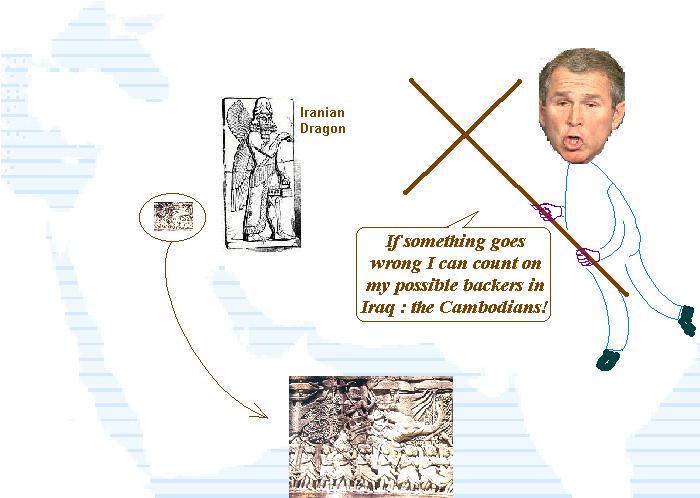
| RENCONTRER
DIEU |
DIEU - VS - BOUDDHA | MEET
WITH GOD |
Après leur rencontre amicale de tennis
au centre Claude-Robillard, Yèm Say et André Tremblay prennent
ensemble un souper chez ce dernier qui n'habite pas loin du complexe sportif,
sur la rue Saint-Hubert. André, qui a visité l'Inde et le
Népal, s'intéresse au bouddhisme et à la méditation.
- Donc les bouddhistes croient à la
réincarnation?
- C'est la base même de la religion!
répond Say. Ce que tu vis dans le présent est le résultat
de ce que t'as fait dans ta vie antérieure.
- Le karma!
- C'est ça! Karma en sanskrit
ou kamma en pali.
André verse le café dans les
tasses, arrête la cassette de musique classique -dont il raffole-
et allume le poste de télévision. (...)
- Et Bouddha, est-il un dieu?
- Non! Il était un homme comme toi
et moi, il était même marié et avait un enfant. C'était
un roi dans le Népal, son vrai nom était Siddharta.
- Il faisait donc la méditation pour
atteindre le Nirvana, le paradis bouddhique?
Say pose sa tasse sur la table et explique:
- Il aspirait à beaucoup plus que le
paradis! Le Nirvana c'est le Néant où il n'y a ni vie ni
mort, c'est la paix absolue. Siddharta ne voulait pas de la vie, laquelle
conduira inévitablement à la mort. Il ne voulait pas avoir
à renaître et remourir encore et encore. Voici comment le
roi comblé et insouciant se mettait à penser à son
salut. Il se leva une nuit avant l'aube pour aller voir un peu sa capitale.
Traversant son palais, il voyait les corps dénudés des servantes
et des laquais qui dormaient sur le plancher: il trouva que la vie c'étaient
les désirs, les passions, les besoins.
«Dans la rue, il voyait un vieillard
qui s'acheminait péniblement en s'appuyant sur sa canne: le roi
se rendit compte que naître c'est pour vieillir. En un autre endroit,
un malade gémissait de douleur: Siddharta voyait que vivre c'est
souffrir. Dans un champ, c'est un cadavre que la famille, larmoyante, incinérait:
le monarque comprit qu'il avait à mourir lui aussi. Enfin le roi
vit un religieux, l'air serein, détaché, heureux: Siddharta
venait de trouver la voie! Pour échapper à la mort, à
la maladie et à la vieillesse, il faut échapper à
la vie. Et pour échapper à la vie il faut renoncer aux besoins,
aux désirs et aux passions que celle-ci engendre!
- Pas jusqu'à refuser de manger et
de se laver! objecte André.
- Il a essayé de le faire! Il est devenu
tout maigre et tout sale, mais il n'a pas trouvé la clé de
l'Illumination.
- Mais oui! s'exclame André. Je me
rappelle avoir vu ces statues de Bouddha barbu et maigrelet!
- C'est ça! C'est pendant qu'il faisait
le tukkha kiriya, la pénitence. Un ange, joueur de vielle,
venait alors lui donner un récital. La corde de la vielle n'étant
pas assez tendue, le son n'était pas agréable. L'ange augmenta
alors exagérément la tension et la corde se rompit. C'est
quand la nouvelle corde fut tendue à la juste mesure que la musique
retentissait délicieusement. Et Siddharta saisit la parabole.
- In medio stat virtus!
André cite un dicton latin et ouvre
une boîte de biscuits.
- C'est ça! La vertu est au milieu.
Say approuve, se sert et continue:
- Il acceptait alors de faire sa toilette,
mangeait les boulettes de riz qu'on lui offrait puis allait s'asseoir sous
le banian où il méditait et trouva enfin l'Illumination.
- D'où le nom de Bouddha, l'Illuminé!
conclut André.
- Ou encore l'Éveillé! complète
Say. (...)
Après avoir avalé un biscuit qu'il fait descendre avec
du thé vert, Say continue sur la religion:
- Tu sais? J'ai parcouru un peu la Bible et
l'Ancien Testament. J'ai trouvé que si Bouddha a renié la
Vie, Dieu recommande à l'homme de jouir de la Vie.
- Oui, mais tout en restant dans la droiture!
Nous autres Occidentaux, on perçoit le bouddhisme comme une religion
de sagesse, de tolérance et de bonté. Je suppose que ce sont
des principes enseignés dans les pagodes?
- Affirmatif! Heureusement le renoncement
n'est pas total. Bouddha savait que tout le monde ne peut pas entrer ¹
au Nirvana. Alors il a laissé des sila, des Commandements
si tu veux, à ses disciples. Pour l'homme ordinaire, un code à
cinq Commandements suffit de faire de lui un être bien:
1) Ne pas tuer.
2) Ne pas voler.
3) Ne pas mentir.
4) Ne pas commettre d'adultère.
5) Ne pas s'énivrer de drogue ou
d'alcool.
- Amen!
André "accueille" les sila le
plus sérieusement du monde.
- Tu devrais dire Ama! Ça veut
dire Oui en pali. Ou mieux: Ama, Bhanté! Oui, Seigneur!
- Ça se ressemble, hein?
- Ben, voyons! L'indo-européen! Le
sanskrit!
- Mais dis-moi! Il y a une prophétie
chrétienne qui prédisait la fin du monde. Est-ce qu'il existe
une telle prophétie chez les bouddhistes?
- Parfaitement! Bouddha lui-même, selon
des textes khmers, prédisait que sa religion durera cinq mille ans.
Après, sept soleils apparaîtront un à un dans le ciel
et la terre brûlera. Ce sera une nouvelle ère géologique:
chhess
kalp en cambodgien.
- Seigneur! gémit André. Ça
relève plus de l'astronomie que de l'astrologie! Mais cinq mille
ans, ça nous laisse encore combien de temps?
- L'ère bouddhique précède
de 543 ans l'ère chrétienne. Alors ça se passera en
l'an 4457. Mais après ce cataclysme viendra un autre Bouddha, le
dernier, que les Khmers appellent Preah Sé Ar Métri.
Avec lui tous les êtres -remarque! j'ai pas dit les humains- vivront
heureux.
______________
¹ Les Cambodgiens disent "monter
au paradis" mais "entrer au Nirvana".

|
(2006-Apr-06) The codex containing the Gospel of Judas was
torn and crumbling before conservation work began.
|
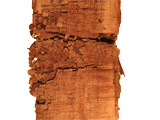 |
NASA spacecraft finds water on Saturn moon (2006-Mar-10)
CTV.ca News Staff : It's almost 1300-million
kilometres from earth but scientists believe they have discovered evidence
of water on one of Saturn's icy moons -- rekindling hope in the existence
of life outside planet Earth. The surprising discovery, made by the Cassini
spacecraft, shows evidence of liquid water reservoirs that erupt from geysers
(natural hot-springs) on Saturn's moon Enceladus. "High-resolution
Cassini images show icy jets and towering plumes ejecting large quantities
of particles at high speed," a NASA press release stated Thursday.
Carolyn Porco, Cassini's imaging team leader said Thursday that the discovery
was a "smoking gun" that proved water existed on the planet. "We realize
that this is a radical conclusion – that we may have evidence for liquid
water within a body so small and so cold," Porco said. "However, if we
are right, we have significantly broadened the diversity of solar system
environments where we might possibly have conditions suitable for living
organisms."
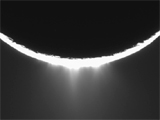 |
Scientists examined reasons for the eruptions and concluded that it could be coming from liquid water reserves. "The jets might be erupting from near-surface pockets of liquid water about 0 degrees Celsius," the report said. While other moons in the solar system have liquid-water oceans buried kilometres below the surface, Saturn's reserve may only be meters below, scientist Andrew Ingersoll said of the discovery. That conclusion has scientists and astronomers in a giddy mood of excitement. "We previously knew of at most three places where active volcanism exists: Jupiter's moon lo, Earth, and possibly Neptune's moon Triton," Cassini scientist John Spencer said in the release. |
| Climate Expert Says NASA Bids to Muzzle Him (2006-Jan-30)
By Reuters : NEW YORK - NASA's top climate scientist said the Bush administration has tried to stop him from speaking out since he gave a lecture in December calling for prompt reductions in emissions of greenhouse gases, The New York Times said Saturday. In an interview with the newspaper, James Hansen, director of NASA's Goddard Institute for Space Studies, said that officials at the space agency's headquarters had ordered the public affairs staff to review his lectures, papers, postings on the Goddard Web site and requests for interviews from journalists. |
 |
God the Father : "Thou shall not murder!"
Buddha : "Panatipata Veramani Sikkhapadam Samadiyami - I endeavour to refrain myself from harming any sentient being."
God the Son : "You shall not murder."
ARE GOD THE FATHER, BUDDHA AND GOD THE SON GOD THE NEGATIVE ?
-oOo-
GOD THE POSITIVE would command : "Defend thyself. Defend thy life even by taking thy aggressor's life!"
| Dalai Lama Links Science, Buddhism (2005-Nov-15)
By ELIZABETH WHITE, Associated Press Writer : WASHINGTON - Science and Buddhism share a quest of open investigation into the nature of reality, and science can be a pathway to discovering well-being and happiness, the Dalai Lama told the Society for Neuroscience on Saturday. Tibet's spiritual leader, speaking alternately in English and through a translator, praised neuroscience - the study of the brain and nervous system - as important work he's been interested in for 15 years. "I believe we want happiness," he said, adding that the way to transform society is through education and by boosting among individuals, families and communities "some of the useful emotions such as compassion or forgiveness." Science is particularly important, he said, because it reaches both the religious and nonreligious and can help identify the factors and forces that promote well-being. |
 |
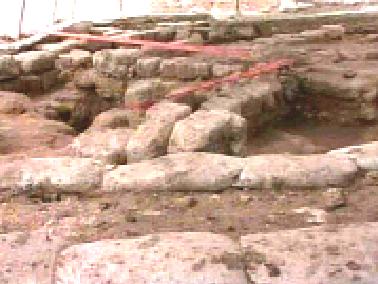 |
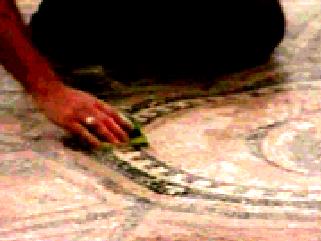 |
Radio-Canada.ca : Des archéologues ont mis au jour en
Israël ce qui pourrait être les restes de la plus vieille église
du monde. Les vestiges ont été découverts lors de
travaux d'agrandissement de la prison de Meggido, dans le nord du pays.
Ce sont les prisonniers eux-mêmes, chargés de certains travaux,
qui ont trouvé ces mosaïques qui pourraient dater du 3e ou
du 4e siècle, et qui recouvraient le sol d'une église.
Dans l'Ancien Testament, la ville de Meggido est présentée
comme l'Armaguédon, le lieu de la bataille entre le Bien et le Mal
supposée marquer la fin des temps. Pour le moment, les experts
s'entendent pour dire qu'il s'agit des plus anciens restes archéologiques
d'une église en Israël. Ils pourraient également être
les plus anciens au monde. Jusqu'à ce jour, on n'avait trouvé
aucune trace d'église datant d'avant le IVe siècle.
La découverte
Deux mosaïques à l'intérieur de l'église relatent
l'histoire d'un officier romain et d'une femme nommée Aketous qui
a fait un don pour la construction de l'église en mémoire
de Dieu. Le dessin d'un poisson, ancien symbole chrétien ayant
précédé la croix, orne l'une des mosaïques.
Les archéologues estiment que la découverte de morceaux de
poterie du IIIe siècle, le style d'écriture grecque utilisée
dans les inscriptions, les anciens motifs géométriques représentés
sur les mosaïques et la présence d'un poisson plutôt
que de la croix laissent penser que l'église n'était plus
en activité au IVe siècle.
|
( PRÉCÉDENT ) |
|
|
|
|
|
|
|
|
|
|
|
|